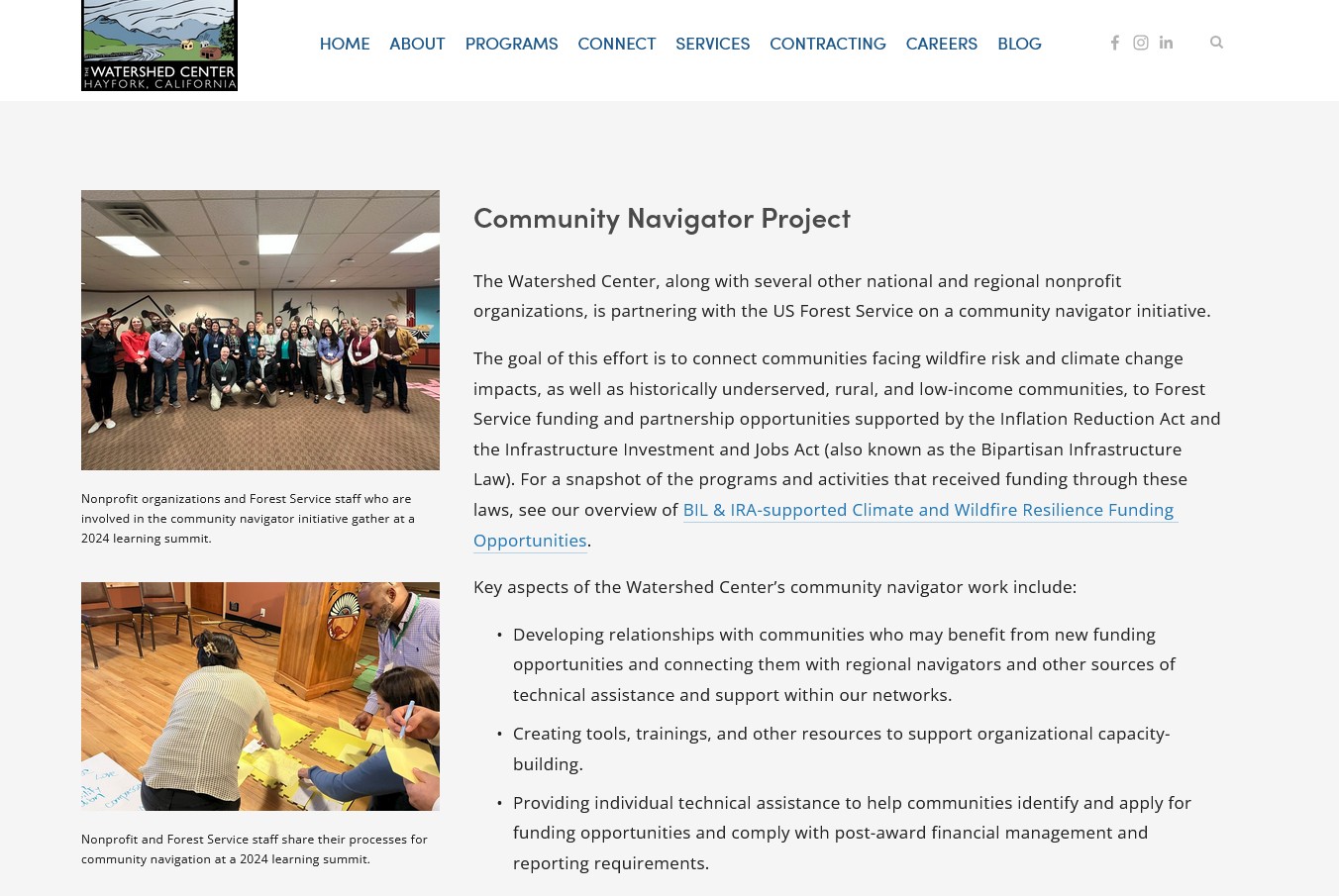Back in February, a reader asked the question “What is the Community Navigators Program?” I asked the Forest Service press office, and heard back in late July.
The Community Navigator initiative is designed to facilitate equitable access to Forest Service opportunities. Community Navigators take a community-centered approach, helping communities:
1) identify available IRA and BIL opportunities that match their needs;
2) create competitive grant and agreement applications for those opportunities;
3) be aware of and stay in compliance with federal funding requirements; and
4) build community capacity to do the first three tasks on their own for future opportunities.
The focus in our communications, etc. is generally around those four Community Navigator “functions”, and is what we ask the partner orgs and FS employee Navigators to do.
While we are still working on putting additional information together for a public release, we don’t have anything additional to offer at this time. Our Community Navigators webpage has some additional information you may find helpful: https://www.fs.usda.gov/working-with-us/navigators
It sounds like they are hiring people on both the FS side and the partner organizations, and I guess they should be doing the communication about it? From the FS website:
Who are our Community Navigator Partners?
To date, the following non-profit organizations have signed agreements to work with communities to help build capacity and share information about Forest Service services, programs and funding opportunities:
- American Indian Alaska Native Tourism Association (AIANTA) was founded to address inequities in the tourism system. They provide technical assistance, training, research and publications; facilitate conversations between Native communities, federal agencies, non-profits, and elected officials; highlight the importance of authentic Native destinations; and generate awareness, interest and demand for Native destinations with travelers, the travel trade, and the media.
- Coalitions and Collaboratives Inc. (COCO) is a national non-profit with a vision for a future where disturbances are less impactful, ecosystems are resilient, and communities thrive. As a collaborative organization, COCO offers capacity-building support to place-based organizations through funding, mentorship, and training. Learn more about COCO’s community navigators work.
- First Nations Development Institute (FNDI) is a Tribal organization which uplifts and sustains the lifeways and economies of Native communities through advocacy, financial support, and knowledge sharing. First Nations envisions a world in which Tribal Sovereignty is upheld, and Native ingenuity and knowledge are honored and respected. Learn more about First Nation’s community navigators work.
- Hispanic Access Foundation (HAF) is a national nonprofit with the goal of connectings Latinos and others with partners and opportunities to improve their daily lives and create an equitable society. We envision a future whereOne day, every Latino in America will enjoy good physical health and a healthy natural environment, a high-quality education, economic success and civic engagement in their community with the sum of improving the future of America. Hispanic Access fosters the development of leaders from our Hispanic communities and elevates their voices in areas where we are underrepresented. Learn more about Hispanic Access Foundation’s community navigators work.
- The Federation of Southern Cooperatives (FSC) is a catalyst for the development of self-supporting communities through cooperative economic development, land retention, and advocacy. The 57-year-old cooperative association serves Black farmers, landowners, and cooperatives.
- The Watershed Research and Training Center (WRTC) conducts land and watershed management services, leads state biomass and fire resilience initiatives and through partnerships with communities, organizations, and public agencies, steward the landscape, create and sustain quality jobs, and connect people to the land and to each other. Learn more about the Watershed Center’s community navigators work.
It looks like the Watershed Center’s description is pretty good. Reading this, it seems odd to me that these Navigators, as written are focused only on BIL and IRA grants, when our world if full of all kinds of other grant possibilities to do the same kind of thing (even within the FS, let alone other federal and state). And I understand that communities can lack capacity and get very frustrated at the complexities of apparently overlapping federal grant programs with different bureaucratic requirements that often don’t quite fit together. In fact, it would be useful for Congress to establish a Community Wildfire Commission to discuss the issues as seen from the community level. Including ideas like… making applying simpler and more consistent.
Now, on the one hand, it makes perfect sense to give traditionally under served communities a leg up. On the other hand, people could question whether this is the best approach to do that- short-term, associated with BIL and IRA. It’s not clear whether the opportunity to be a partner organization was an open process, and I’m not sure it’s clear how much funding is involved- maybe others know?

It is rather disappointing that it took this long to receive a response to a seemingly simple question, but it is good that we did hear back!
I would be curious to know how much funding these six organizations received under their agreements Sharon, could you make this inquiry?
These agreements seem to be funding six organizations to help other organizations and entities apply for, receive, and manage grants and agreements. I will let other commenters consider this and perhaps share their thoughts.
I’ll take your question and hopefully others will add theirs, and will ask or FOIA if necessary.